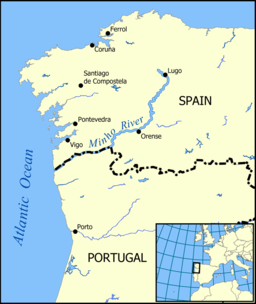- Minho River
-
Miño (Spanish)(Galician)
Minho (Portuguese)River Name origin: Minius (Latin) Countries Spain, Portugal City Lugo, Ourense Source Pedregal de Irimia - location Serra de Meira, Lugo, Galicia, Spain - elevation 695 m (2,280 ft) - coordinates 43°12′41″N 7°16′52″W / 43.21139°N 7.28111°W Source confluence Peares - location Ourense, Galicia, Spain - coordinates 42°27′14″N 7°43′48″W / 42.45389°N 7.73°W Mouth Miño Estuary - location Atlantic Ocean, Spain & Portugal - elevation 0 m (0 ft) - coordinates 41°52′0″N 8°52′12″W / 41.866667°N 8.87°W Length 350 km (217 mi) Discharge - average 340 m3/s (12,007 cu ft/s) Reservoirs Belesar, Peares, Velle, Castrelo and Frieira - Rio Minho redirects here. For the river of that name in Jamaica, see Rio Minho (Jamaica)
The Minho (Portuguese: [ˈmiɲu]) or Miño (Spanish: [ˈmiɲo], Galician: [ˈmiɲo]) is the longest river in Galicia, Spain, with an extension of 340 km.
Both names come from Latin Minius. The Minho waters vineyards and farmland, is used to produce hydroelectric power, and also delineates a section of the Spanish/Portuguese border.
The source of the Minho lies about 50 km north of Lugo in Galicia, in a place called Pedregal of Irimia. The river passes just south of the walls of this old Roman city and flows south through canyons until the valley widens north of Ourense. The river has been harnessed in reservoirs from Portomarín to Frieira. In its length it has the following reservoirs: Belesar with 654 hm³, Peares with 182 hm³, Velle with 17 hm³, Castrelo with 60 hm³ and Frieira with 44 hm³.
Twenty kilometers north of Ourense at Os Peares the Minho receives the waters of its main tributary, the Sil. Passing Ourense, the river flows in a southwest direction until reaching the Portuguese border near Melgaço. There is one major dam at Frieira near the town of Ribadavia, which is famous for its Ribeiro wine (called after the name of the region).
The Portuguese Minho divides the two countries for about 80 km. The valley is a lush, green agricultural area where every square metre of land is used to produce corn, potatoes, cabbage, or just grass, depending on the time of year, and everywhere edging the fields, rivers and gardens, wherever there is space, the vines which produce the light, slightly sparkling “Vinho Verde” peculiar to this area. The very best of these, Alvarinho, is produced in the area around Monção and Melgaço.
Passing the medieval towns of Melgaço and Monção the Minho divides the Spanish Tui and Portuguese Valença do Minho, towns that guarded an important crossing for road and rail. Both towns preserve fortifications and are national monuments. The Minho reaches the Atlantic near Caminha.
Contents
Tributaries
Right
- Pontevedra
- Río Tamuxe (also called Carballas, Carballo or Carvallo)
- Río Pego
- Río Cereixo da Brinha
- Río Furnia (also called Forcadela)
- Río Louro
- Río Caselas
- Río Tea
- Río Deva (there is another Deva River on the left bank)
- Río Ribadil
- Río Cea
- Ourense
- Río Avia
- Río Barbantiño
- Río Bubal
- Lugo
- Río Asma
- Río Narón
- Río Ferreira
- Río Mera
- Río Narla
- Río Ladra
- Río Támoga
- Río Anllo
Left
- Portugal
- Rio Mouro
- Rio Gadanha
- Rio Coura
- Ourense
- Río Deva
- Río Arnoia
- Río Barbaña
- Río Lonia
- Sil River
- Río Sardiñeira
- Río Loio
- Río Neira
- Río Chamoso
- Río Robra (also called río Santa Marta)
- Río Lea
- Río Azúmar
See also
- List of rivers of Spain
External links
Categories:- Minho basin
- Rivers of Galicia
- Rivers of Spain
- Rivers of Portugal
- International rivers of Europe
- Portugal–Spain border
Wikimedia Foundation. 2010.



